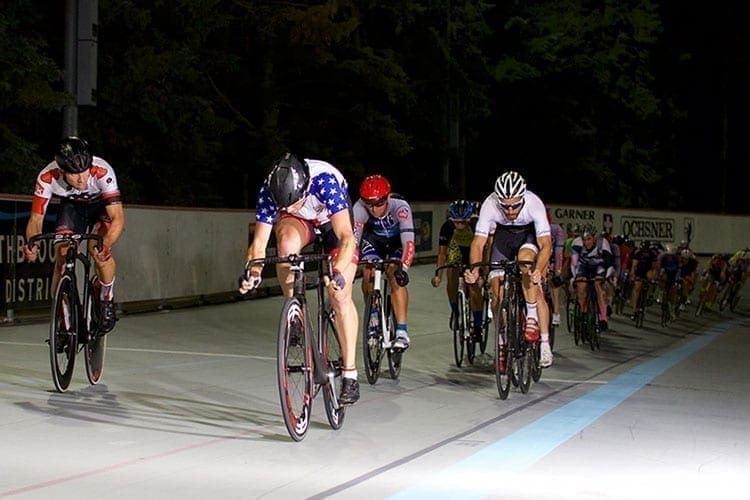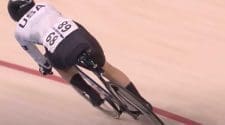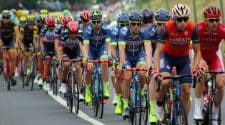The History of Track Cycling
Track cycling goes back to about 1870. There was no indoor velodrome back then, but the track was similar to what we have to today, The length was changed to 250 meters for the Olympic velodrome with a wood surface. You can still race concrete tracks all over the world at a length of up to 500 meters.
Track cycling became an Olympic discipline in 1912.
Velodrome racing attracted a lot of people, especially in England and later in the USA where it became a very popular sports in the 1940s – 1960s. The great thing about track cycling was that it was very entertaining and people could watch the race from start to finish sitting in one place.
Track Rules
Bike
What is beautiful about track bikes?
Simplicity, you take everything off it and just keep the chain, there are no brakes and no gears. The bikes are a fixed gear, so you have more control over your bike with your legs.
UCI made a rule about tubes you can use to build track bikes with, it is simply 3 to 1 ratio of length to width.
Velodrome
Different velodromes can have little different lines on it. But there are a few lines you will always see there.
The inner line which you can ride on, this is a peace zone where you go if you are out of the race.
The next 2 thin lines create a sprint-line. This is the shortest and the fastest way to go around the track.
In a middle way between sprint line and band, you can see the paceline, you stay above it when you keep a more steady pace for example during madison events.
Remember that you pass others on the outside.
Never change your line before checking what is going on behind you. Someone can be sprinting at 40 miles per hour!
Track Racing
Sprints
Sprints are a very short events for example 200 m, 500 m. You can do it solo, flying 200 and the best time win or you can compete in pairs, the first person on the line wins.
Team Sprint
Team Sprints are like individual sprints but with the team.
Time Trial
A Time Trial has standing start events that are a race-specific distance and raced as fast as possible.
Keirin
A Keirin race is racing behind a motorbike!
Pursuit
For the Pursuit, 2 cyclists start on the opposite parts of the track and fight with the fastest time.
Team Pursuit
The Team Pursuit is the same as individual events but with the team.
Scratch Race
The Scratch Race can be compared to criterium racing, where the first person over the finish line wins the race. The events are 20 – 100 laps.
Points Race
A Points Race is like scratch racing, but you get points for every 5, 10 laps. A person with the highest number of points on the finish line wins the race.
Madison
In the Madison, you race in pairs! Extremely “explosive” race with effective and dangerous changes between team members.
Elimination Race
In an Elimination Race, the last person on the finish line is out of the race every 1 or 2 laps. With 2 cyclists left, it is switched to scratch race rules.
Omnium
The Omnium is an overall classification for a few races. Cyclists with the highest number of points wins.
What are the Benefits of Velodrome Racing?
Did you ever race on track?
Track or velodrome racing can be very beneficial for other types of cycling like road cycling, cyclocross or mountain biking.
Beside Time Trials, cycling is never steady like long-distance running where you need to keep the same high pace for whole duration or race. In cycling, we can see a constantly changing speed, with smaller and bigger accelerations which many times knock you out of the race.
Track cycling is mostly about extremely hard accelerations and being able to repeat them as many times as possible. We are talking about hitting your sub-maximal and maximal watts multiply times.
We always see track cyclists with big hips and looking more like bodybuilders then cyclists. And that is true that track cyclists spend more time at the gym then riding their bikes.
But it doesn’t mean that you can’t benefit from track cycling! Actually, this explosive power can help you in many situations on the road or off-road.
For example, when riding in the group and someone has created gap in front of them, and now you need to close this gap, you can spend a few minutes to try to close it very steadily with group of riders on your wheel or you can accelerate for 6-8 seconds and catch up with the group in front.
You need those accelerations in cyclocross when someone blocks you and you need to slow down, coming out of the slower turns or during longer straits where you can pass riders.
Take advantage of track cycling and if you have a chance and put it into your weekly training plan, and remember one most important rule of track cycling “you go as hard as possible or as easy as possible”.
Southern California Velodromes
Article by Damian Chlanda, Cyklopedia
No products found.


















